Cathay Pacific has welcomed the first of its 20 Airbus A350-1000 on order. Eight of these aircraft will be delivered this year, with the remainder due to arrive by 2021.
All 20 A350-1000s will be flown from Toulouse, the home of Airbus, to Hong Kong using a blend of alternate jet fuel. Compared to traditional jet fuel, sustainable biofuel can reduce life cycle greenhouse gas emissions by up to 80%.
Passengers can experience Cathay Pacific’s A350-1000 for the first time on 1st July 2018, when it makes its inaugural flight from Hong Kong to Taipei.
The aircraft, which supersedes the A350-900, will then be launched on some regional services, before entering service on Cathay Pacific’s new route to Washington DC on 15th September 2017. At 8,153 miles, this will be the longest route on the airline’s network.
Airbus’ most technologically-advanced A350 will also serve Madrid, Tel Aviv, Amsterdam, Manchester and Zurich from the coming winter.
Cathay Pacific Chief Customer and Commercial Officer Paul Loo said: “We already have one of the youngest long-haul fleets in the sky, and with the arrival of the A350-1000, our fleet is only going to get younger.
“The aircraft follows the successful entry of the -900 variant which has enabled us to expand our long-haul network at a near unprecedented rate, providing our customers with a wider range of non-stop travel choices, while at the same time strengthening Hong Kong’s position as Asia’s largest international aviation hub.
“The -1000 is very similar to the -900 in terms of its operational excellence. It has an incredible range, is remarkably fuel efficient and quiet, provides customers with an unsurpassed cabin environment and has extremely attractive operating economics.”
Features of the new A350-1000
Cathay Pacific’s A350-1000s carry a total of 334 passengers – 54 more passengers more than the airline’s A350-900s.
Business Class features a total of 46 seats arranged in a 1-2-1 layout with window seats angled towards the window and the centre seats angled inwards towards each other. The seats are still Zodiac seats measuring 20.2 inches wide and converting into 75-inch-long beds, but they are now housed in one single cabin as opposed to being split across two sections.
The new aircraft also features an advanced inflight entertainment system and LED mood lighting, plus enhanced Wi-Fi connectivity so that passengers can stay connected throughout the journey. A higher cabin pressure supplies more oxygen to lower the effective cabin cruising altitude to 6000 ft, which should reduce passenger fatigue.













PLEASE LEAVE YOUR REVIEW...